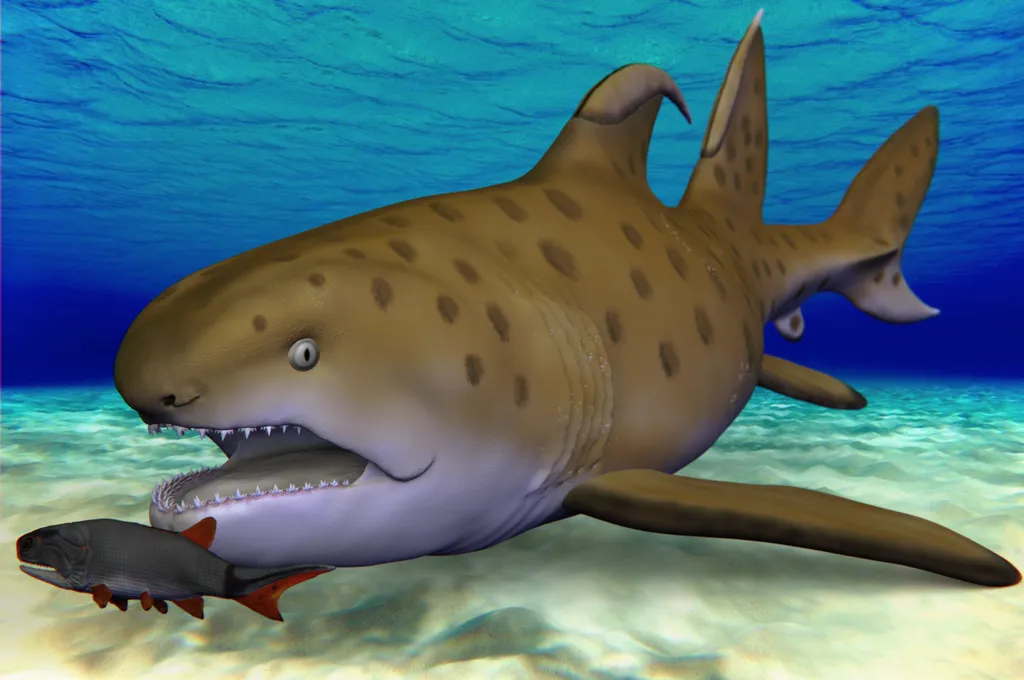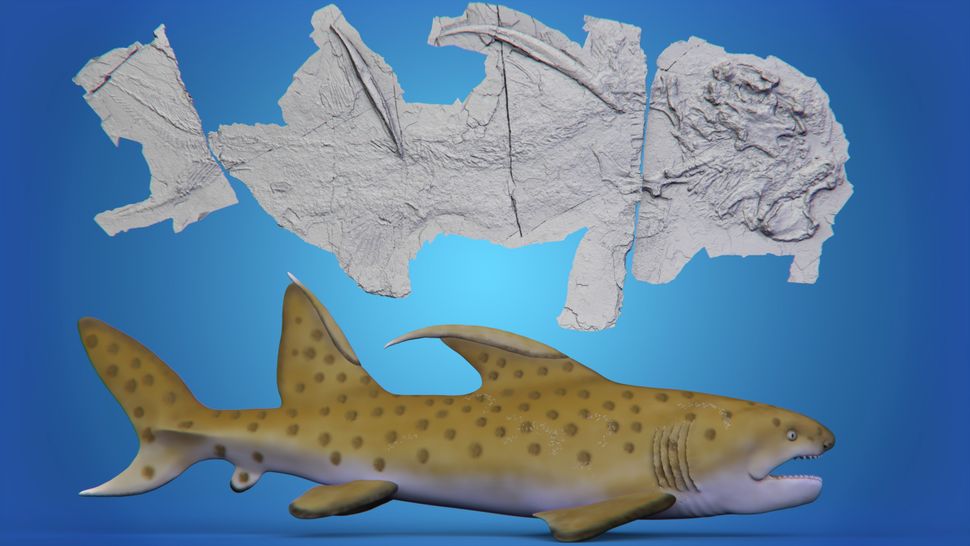300 million-year-old 'Godzilla shark' identified
as new species, gets
a new name
새로운 종으로 확인된 3억년된 "거대한 괴물
상어"는 새로운 이름을 갖게된다.
By Harry Baker - Staff Writer 22 April 2021
2021년 4월 22일 전속작가 -해리 베이커에 의한 글
The monster-like shark was first discovered in 2013.
그 괴물 같은 상어는 2013년도에 처음으로 발견되었다.

would have been equipped with 12 rows of piercing teeth and a pair of 2.5-foot-long
br>
(0.8 meters) fin spines on its back.
(Image credit: Jesse Pruitt/New Mexico Department of Cultural Affairs.)
이 예술적 개념의 삽화에서 보여지는 모습의 그 거대한 괴물 상어는 톱니 12줄,
그리고 그것의 등에 한쌍의 2.5-푸트-길이(0.8미터) 지느러미 척추를 갖추었을
것으로 보인다.
(이미지 저작권: 뉴 멕시코 문화부/제시 프루이트)
A 300 million-year-old shark relative, nicknamed the Godzilla shark after its discovery in 2013,
has finally received a proper name after being classified as its own species.
2013년도 그것의 발견에 이어 거대한 괴물상어라 별명이 붙게된 3억년이나 된
친척 상어는 마침내 그것의 자신의 종으로 븐류되어짐에 따라 고유이름을
부여받게 되었다.
Paleontologists found the unusually complete and well-preserved 6.7-foot-long
(2 meters) fossilized skeleton of the ancient shark at a private site in the Manzano
Mountains near Albuquerque, New Mexico.
Standout features of the skeleton include 12 rows of piercing teeth set in robust,
powerful jaws, and a pair of 2.5-foot-long (0.8 m) fin spines on its back.
고생물학자들은 신멕시코 앨버커키 근처의 만자노 산맥에 있는 사유지에서
대개 그렇듯 완전하게 잘보존된 6.7 푸트(2미터) 길이의 고대 상어의 화석화된
뼈대를 발견하게 되었다.
그 뼈대의 두드러진 특징으로 튼튼하고 강력한 턱부분에 12줄의 톱니 세트
와, 그리고 그것의 등에 한쌍의 2.5푸트 길이(0.8미터)의 지느러미 등뼈를 포함
한다.
It was nicknamed the Godzilla shark because of its size — the skeleton is the largest fossil of
its kind ever discovered in the area —
and the reptilian nature of the spines on its back, John-Paul Hodnett, who first unearthed
the fossil and led the new research, told Live Science.
그 뼈대가 그 지역에서 여태 뱔견된 그것의 종류중의 가장 큰 화석이고---그것은
그것의 크기 그리고 그것의 등위에 척추라는 파충류의 본성때문에-- 거대한
괴물상어라는 별명이 붙게되었는데, 존 폴 호드넷, 그는 처음으로 그 화석을 발굴
했고, 그리고 그 새로운 연구조사를 이끌어갔다, 라고 라이브 사이언스에 말했다.
Related: 7 unanswered questions about sharks
관련내용: 상어에 대한 7가지 미답된 질문
"I am also a big fan of the Godzilla film franchise," Hodnett, a paleontologist at the Maryland-National
Capital Parks and Planning Commission, said.
"나는 또한 거대한 괴물 영화의 독점 판매권에 대한 열렬한 팬입니다," 라고 메릴랜드
주립수도공원계획위원회의 고생물학자 호드넷씨는 말했다.
"So when the features of this shark came to light, I thought it was the perfect nickname."
"그래서 이 상어의 그 특징이 밝혀졌을 때, 난 그것은 완연한 별명이라고 생각하게
되었습니다."
The shark has now been officially named Hoffman's dragon shark (Dracopristis hoffmanorum),
after the family that owned the land where the skeleton was found,
and as an homage to its monstrous, reptilian appearance.
그 상어는 이제 그 뼈대가 발견되어졌던 땅을 소유한 가정을 본따, 그리고 그 무시
무시한 파충류적 풍채에 대한 경의의 표시로써, 공식적으로 호프만 용상어 (Dracopristis
Hoffmanorum)라고 명명되어지게 되었다.
"It is very rare to find skeletal material of ancient sharks,
let alone a complete skeleton that also preserved the body outline and other soft tissue impressions,"
Hodnett said. "That and it being a new species was also amazing and unique."
"또한 그 몸통의 윤곽과 그리고 기타 연조직이 인상스럽게 보존된 완전한 뼈대는 커녕
고대의 상어의 뼈대물질을 발견하기란 매우 진기한 일입니다," 라고 호드넷씨는 말했다.
"무엇보다 새로운 종이라는 것 또한 놀랍고 독특했습니다."
Ancient relatives
고대의 친척

The fossilized skeleton of the Godzilla shark next to an artist's rendering of what it may have
looked like.
(Image credit: New Mexico Museum of Natural History & Science (NMMNHS))
그것이 그렇게 보였을런지도 모르는 예술가의 작품을 옆으로하는 거대한 괴물 상어의
화셕화된 뼈대
(이미지 저작권: 신멕시코 자연 역사과학 박물관 (NMMNHS))
Hoffman's dragon shark belonged to a group of mysterious ancient sharks known as
the Ctenacanths which diverged from modern sharks and rays around 390 million years ago during the Devonian Period.
The exquisitely preserved skeleton enabled the researchers to learn more about this poorly understood group.
호프만의 용상어는 광선처리결과 약 3억 9천년 전의 디본기동안에 현대의 상어로부터
갈라졌던 세테나칸스로 알려진 신비한 고대의 상어의 그룹에 속했다.
이 정교하게 보존된 뼈대는 연구조사자로하여금 이 형편없이 이해된 그룹에 대하여 더
많이 알게끔 해주었다.
One of the biggest differences between the Ctenacanths and modern sharks is their jaws.
"Their [Ctenacanths] jaws are larger, more firmly attached to the cranium, making them less flexible,"
Hodnett said.
세테나칸스 상어와 현대 상어들 사이의 가장 큰 차이점 중의 한가지는 그들의 턱이다.
These fixed jaws may mean Ctenacanths were not apex predators as modern sharks are.
Instead, the new fossil suggests they may have occupied a different ecological niche.
이들 고정된 턱은 세테나칸스 상어들이 현대의 상어들이 그런것과는 달리 제일의 포식자들이 아니었음
을 의미할런지도 모른다.
대신에, 새로운 화석에서는 그들은 서로다른 생태학적 틈새를 점령했을런지도 모른다는 사실을
제시하고 있다.
"From the anatomy of the pectoral fins and tail we propose that Dracopristis was most likely a predator
that kept close to the bottom of the ancient lagoon estuary it lived in," Hodnett said.
"The teeth are also more adapted for grasping and crushing prey like crustaceans and small vertebrates."
"가슴 지느러미와 꼬리에 대한 해부학으로부터 우리는 드라코프리티스는 그것이 살았던 고대의
작은 늪 어귀의 기슭 가까이를 유지해 머물렀던 조상임이 아주 그럼직할 것같다는 의견을
제시합니다," 라고 호드넷씨는 말했다.
"그 잇빨은 또한 갑각류와 작은 척추동물처럼 먹이를 포획하여 부수어주는데 더 잘 적응
되는 것으로 보입니다."
The large spines on the back of Hoffman's dragon sharks may have been used as defense against larger sharks,
the researchers suggest. Large shark teeth found in the area provide evidence that this is the case,
according to a press statement from the New Mexico Museum of Natural History & Science (NMMNHS).
호프만의 용상어의 등부분의 거대한 척추는 더 덩치가 큰 상어에 대항하여 방어용으로
사용되었을런지도 모른다, 라고 연구조사팀에서는 제안한다.
신멕시코 자연역사 과학 박물관 (NMMNHS)으로부터의 출판물에 따르자면, 그 지역에서
발견된 거대한 상어의 잇빨에서 이것이 그 경우라는 증거로 제시되는 것이다.
The Ctenacanths went extinct during the mass extinction event at the end of the Permian Period 252 million years ago,
which brought an end to the Paleozoic Era. However, the exact cause of the sharks' demise is still unclear.
세테나칸스는 2억 5천 2백만년의 페름기의 말에 집단적 멸종 이벤트동안에 멸종되었으며,
이것은 고생대말을 야기시켰다.
그러나 그 상어들의 죽음의 정확한 까닭은 여전히 명백하지 않는 부분이다
The researchers are now looking for more Ctenacanth fossils in the area to learn more about their life-history traits —
evolutionary characteristics such as longevity, growth rate, age of reproductive maturity and reproductive output.
연구조사팀에서는 현재 장수, 성장률, 나이별 생식기의 성숙도와 생식기의 생산량과 같은
그러한 획기적인 특성인 그들의 생활의 역사적 특질에 대하여 더 많이 알아보기위해
그 지역에서의 더 많은 세테나칸스의 화석을 찾고 있다.
"We can't reliably reconstruct the life-history traits of a species based on one specimen alone,"
co-author Eileen Grogan, a biologist at Saint Joseph's University in Philadelphia, told Live Science.
"A more holistic understanding of life-history traits requires greater sampling across sizes, sexes,
and the environments in which the organism existed."
"우리는 한 종에만 근거를 두어 어떤 종의 그 생활 역사의 특징을 확실하게 재건해낼
수 없답니다," 라고 필라델피아 세인트조셉 대학의 생물학자이자 공동 저자인 아일린
그로건씨는 라이브 사이언스에 말했다.
생활-역사의 특질에 대한 더 많은 총체적인 이해를 위해 그 유기체가 존재했던 곳에서의
크기별, 성별, 그리고 그 환경을 통한 더 거대한 표본추출이 필수적입니다."
The study was published online April 15 in a NMMNHS Bulletin.
논문은 4월 15일 NMMNHS 게시판에 발표되었다.
Originally published on Live Science.
라이브 사이언스에 원본으로 출간됨.

댓글 없음:
댓글 쓰기